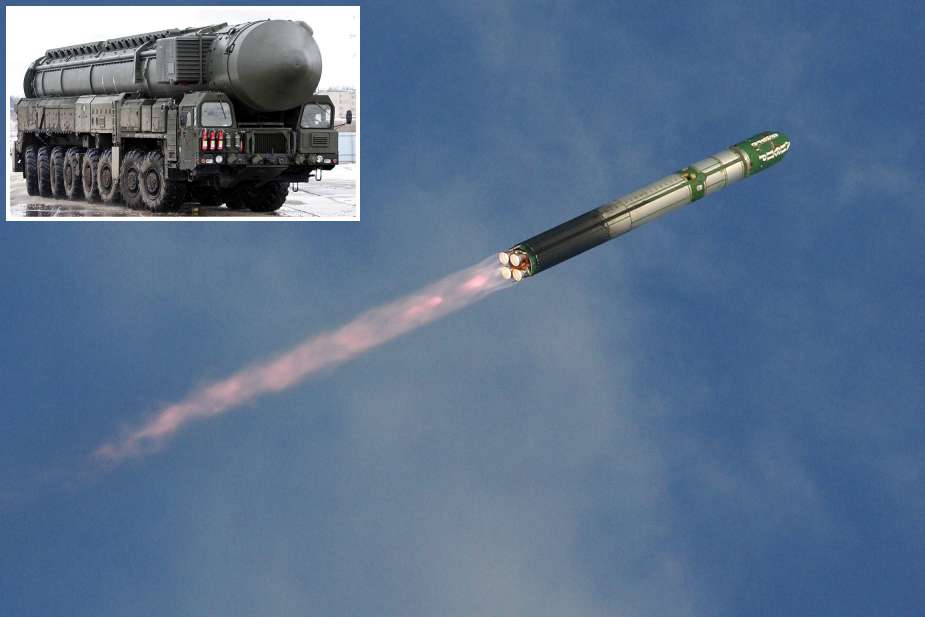Breaking news
Russia accelerates RS-28 Sarmat Satan 2 ICBM production for nuclear supremacy.
As reported by La Prenza Latina on October 5, 2023, in a significant development, Russian President Vladimir Putin has announced the early commencement of mass production of the RS-28 Sarmat heavy intercontinental ballistic missile also nicknamed Satan 2, NATO code-named SS-X-30. This announcement came during his speech at the Valdai Debate Club in the Black Sea resort of Sochi. The Sarmat missile, often referred to as Russia's next-generation Intercontinental Ballistic Missile (ICBM), has undergone extensive testing throughout 2022, indicating Russia's commitment to maintaining its strategic capabilities, as this missile is designed to carry 10-15 individually guided nuclear warheads.
Follow Army Recognition on Google News at this link

The Sarmat Intercontinental Ballistic Missile (ICBM), nicknamed Satan II, could carry 10 to 15 individually guided nuclear warheads up to 18,000 km. (Picture source: Yandex)
The Sarmat is a substantial missile system, featuring an intercontinental liquid-fueled ballistic missile weighing over 200 tonnes. It is designed to replace the Voevoda missiles, colloquially known as the 'Satan' missiles, in Russia's strategic arsenal. The missile is designed to carry 10-15 individually guided nuclear warheads, potentially enhancing Russia's nuclear capabilities. As a reminder, Russia officially placed its RS-28 Sarmat ICBM missile system on combat duty on September 1, 2023.
One of the key assertions made by Russia regarding the Sarmat is its ability to potentially bypass current or prospective missile defense systems. It boasts an impressive range of 18,000 km, theoretically allowing it to target a wide range of locations worldwide, like the nuclear-powered missile Burevestnik. Furthermore, its warheads are equipped with specialized equipment, which some claim could make them challenging to detect during flight, both within and beyond Earth's atmosphere.
The Russian Defense Ministry has expressed confidence that the Sarmat's target engagement range could enhance Russia's strategic nuclear forces. The RS-28 Sarmat project's experimental development began in 2011, with its inaugural test launch occurring in April 2022.
The Sarmat missile is equipped with a modern control system, enabling it to potentially maintain its course when facing anti-missile defenses. Vladimir Degtyar, the chief designer at the Makeyev Rocket Design Bureau, responsible for the RS-28's development, highlighted this feature.
Additionally, the Sarmat's propulsion system is noteworthy. It is a three-stage liquid-fueled heavy ICBM carrying 178 tons of fuel. The missile consumes a significant amount of fuel at the start, but the stages separate, allowing the missile to retain energy. The third stage has four engines that develop a thrust of over 100 tons, potentially increasing the missile's range and making it challenging for hostile missile defenses to intercept it.
Despite these advancements, it is essential to note that the Sarmat has faced international scrutiny and skepticism. According to the US analysis center Nuclear Threat Initiative, Russia conducted at least 13 tests of this missile between 2017 and 2019, and some reports suggest these tests were not entirely successful, raising questions about the reliability and effectiveness of the weapon system.
In response to concerns about the RS-28 Sarmat, Putin has ruled out the need to modify Russia's military doctrine. He stated that Russia would only resort to using nuclear weapons if it suffered a nuclear attack or if the existence of the Russian state was threatened, even by conventional weaponry. Furthermore, Putin issued a stern warning that any aggression against Russia would be met with a response involving the launch of "hundreds of missiles" to prevent an adversary from having a chance to survive.


























